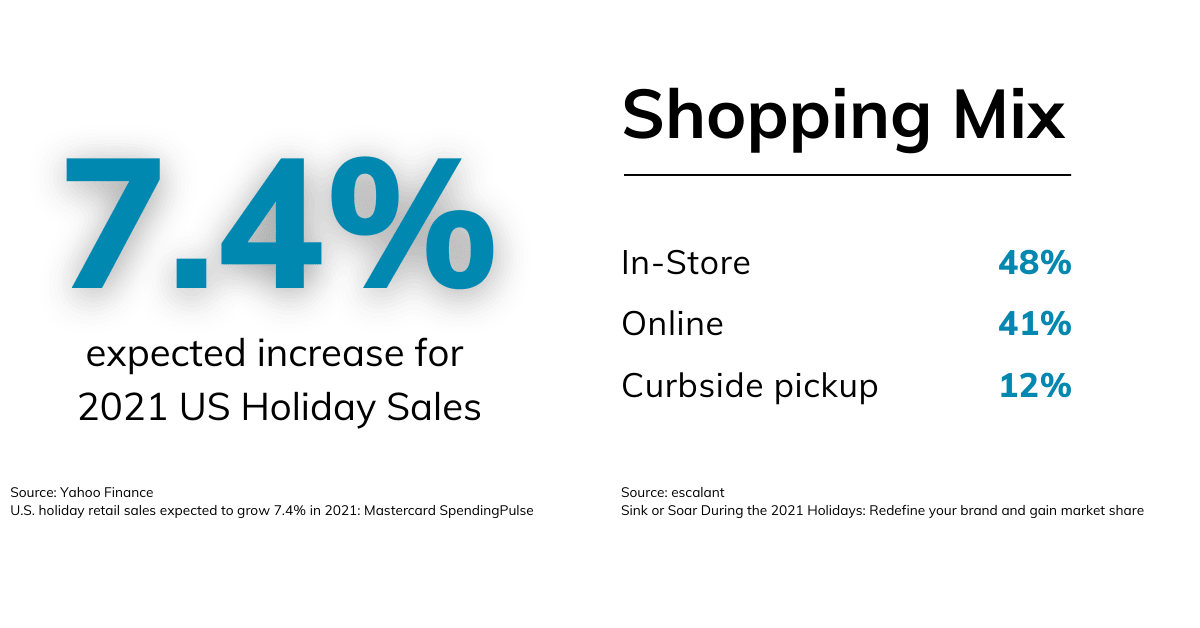After last year's record holiday sales growth (Yes, record – except for fashion retailers), this holiday is heating up to be another great year, with US sales expected to grow by 7.4%. Even clothing and other discretionary spending are expected to rise. But if the correct amount of inventory is not placed in the right locations, all that opportunity is lost.
Last year wiped away any doubts about the importance of omnichannel to a retailers' success. Target's sales in one year surpassed their previous 11, and Walmart announced $14 billion in Capex spending for supply chain, automation, and omnichannel improvements. This year will be no different as consumers plan to do 48% of their holiday shopping in brick-and-mortar stores, 41% via online retail, and 12% through curbside pickup service.
 So here's the conundrum:
So here's the conundrum:
Online sales will explode, and customers want various fulfillment options (in-store, pickup, ship to home, same day, etc.). So how do you ensure you get the sale and that you can fulfill it meeting customer expectations without destroying your margins? Especially when
- Your DC can't fulfill all online orders because of capacity constraints.
- You're shipping from stores or other DC's that aren't ideal.
- You're splitting order shipments.
- Your customers are simply walking out of stores or not buying because they can't find the item, or it'll take too long to get it to them.
What's the solution? The top-of-mind answer is to fix the fulfillment. While that will help, the problem will persist. For example, to stop split ships, you institute a policy that they aren't allowed. While that will stop split ships, you'll still have issues if all the items on a customer order aren't at the DC or a single location.
An ideal solution is to predict the customer demand and anticipate where and how they will want it fulfilled for every location. Then you can align your inventory and plan your labor accordingly. Set yourself up for success. Or another analogy - in football, you must be in the best offensive position before the snap. It doesn't matter how well you execute if you're in a goal-line formation on 3 and 20; it'll take a miracle for you to get a 1st down.
Retailers are already converting some existing store locations to help with fulfillment, so now you need the proper inventory and quantity for the store and online demand. Using a demand forecast to predict store demand and adding an arbitrary amount for web fulfillment won't work when online revenues exceed 40%. Yet, it is incredibly complex to evaluate all the demand drivers to formulate this combined store & online demand forecast. But now, AI advancements have made this a reality. When researching successful digital transformations, such as some of antuit.ai's customers, David Simchi-Levi, Head of MIT Data Science Lab, and Kris Timmermans, Sr. Managing Director, Accenture discovered the following:
"The analytic technology today is mature enough to allow a single SKU, weekly forecast to be decomposed into its basic components. This is done by explicitly modeling the data as a combination of key variables (competitors' behavior and so on) and estimating the contribution of each one to the forecast."
Furthermore, they acknowledged that it "helped to boost market share by more than 28% and double operating profit in just three years" at a fashion retailer.
Real solutions to these problems exist. At antuit.ai, we've recently made our Omnichannel-aware Forecasting, Allocation, & Replenishment generally available to the market. According to co-CEO Yogesh Kulkarni, "Omnichannel-aware is all about positioning inventory intelligently, within your DC and store network, to be closest to the customer to enable fulfilling demand in-store, curbside or delivered to home in the most profitable way while meeting and exceeding service level expectations." In other words, it aligns your inventory to the omnichannel demand.
A Unified Demand Signal is the foundational element of this solution. This single AI forecast connects all inventory decisions for each stage of the product lifecycle. It predicts customer demand and returns by evaluating every driver, including seasonality, pricing, promotions, and events.
This unified demand signal is then shared across inventory systems, and business rules are streamlined to connect processes and decisions revolving around an accurate view of customer demand. In this manner, inventory is intelligently and efficiently pre-positioned for future customer orders in-store, online, BOPIS, and ship from store.
As retailers continue to work through this transformational period, there are no indications that shopping will become less interconnected. If anything, it will become more complicated. Convenience, price, speed, and fulfillment will all be part of the decision. These changes won't occur gradually over some nice smooth trend line, but come suddenly, as the last 18 months have reminded us all.

